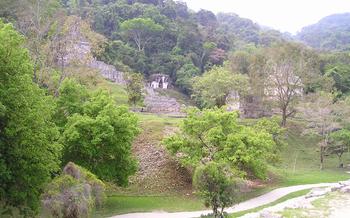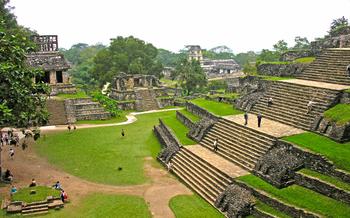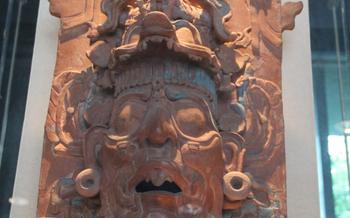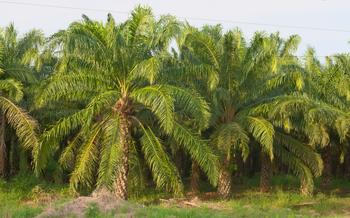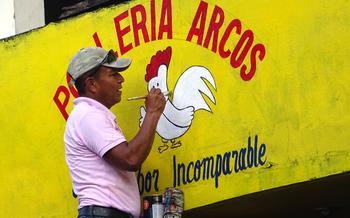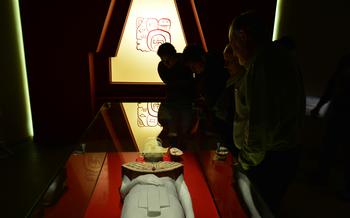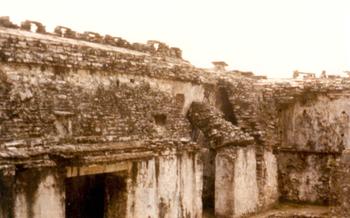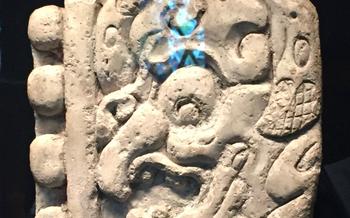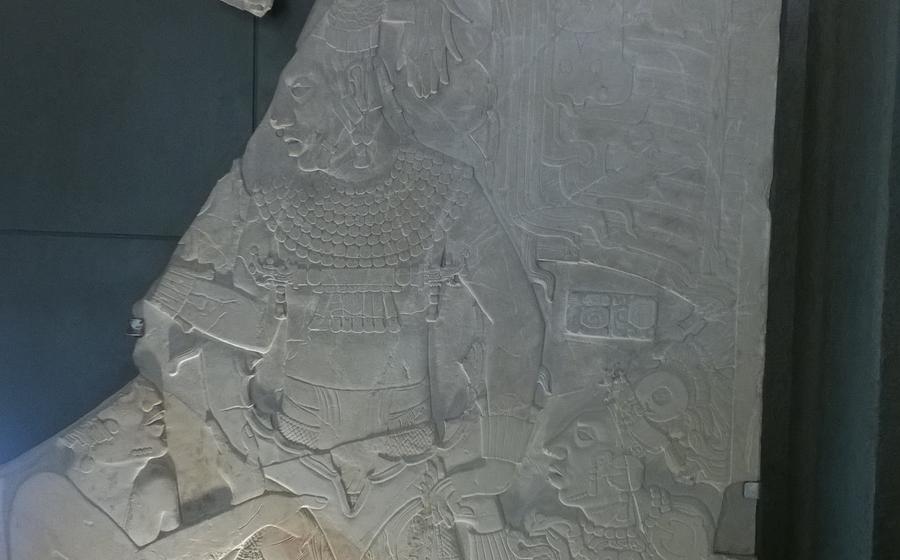
Temple XIX
- Temple XIX: A Mayan Masterpiece
- Location and Accessibility
- Guided Tours and Exploration
- Architectural Wonders
- Symbolism and Iconography
- Restoration and Preservation
- Mysteries and Theories
- Connecting with Mayan Culture
- The Palenque Archaeological Zone
- Wildlife Encounters
- Palenque Town
- Local Markets and Artisan Crafts
- Photography Tips
- Safety and Precautions
- Insider Tip: Embracing the Magic of Dawn
Temple XIX: A Mayan Masterpiece
Temple XIX stands as a testament to the architectural prowess and religious beliefs of the ancient Maya civilization. Built in the 7th century AD, this awe-inspiring structure is considered one of the finest examples of Mayan architecture and is a must-see for any visitor to the Palenque archaeological site in Mexico.
The temple's significance stems from its association with K'inich Janaab' Pakal, one of the most renowned rulers of Palenque. Dedicated to the Mayan sun god, K'inich Janaab' Pakal, the temple served as a sacred mortuary temple where his remains were interred in an elaborate tomb beneath the structure.
Temple XIX showcases a remarkable fusion of architectural elements and intricate carvings that provide valuable insights into Mayan cosmology, mythology, and religious practices. Its grand facade features a series of carved panels depicting scenes from Mayan mythology and history, while the interior boasts a vaulted ceiling supported by a corbelled arch, a testament to the Maya's advanced engineering skills.
Location and Accessibility
Temple XIX is situated within the heart of the Palenque archaeological site, a sprawling complex of ancient Mayan ruins nestled amidst the lush Mexican rainforest. Reaching Palenque is relatively straightforward, with several transportation options available. The nearest city, Villahermosa, offers direct flights from major hubs in Mexico and the United States. From Villahermosa, you can take a comfortable bus ride or rent a car for the scenic 2-hour drive to Palenque. Once in Palenque, local taxis or tuk-tuks can whisk you to the archaeological site's entrance.
To make the most of your visit, plan your trip during the dry season, which typically runs from November to April. This period offers pleasant weather conditions, with sunny skies and minimal rainfall, ensuring a more enjoyable exploration of the site.
Guided Tours and Exploration
Guided tours are readily available in various languages at the Palenque archaeological site, offering an enriching experience for visitors seeking a deeper understanding of Temple XIX and Mayan culture. These tours typically cover the history, architecture, and significance of the temple, providing valuable insights into its construction, purpose, and symbolism. Engaging with knowledgeable guides allows visitors to ask questions, gain expert perspectives, and appreciate the nuances of the site.
While guided tours offer a structured and informative experience, independent exploration can provide a more personal and intimate encounter with Temple XIX. Visitors can wander at their own pace, take time to admire the intricate carvings, and contemplate the mysteries that surround this ancient masterpiece. Exploring independently allows for a deeper connection with the temple's energy and the surrounding rainforest environment.
Architectural Wonders
The grand facade of Temple XIX is a testament to Mayan craftsmanship and artistry. Intricate carvings and sculptures adorn the exterior, depicting various deities, mythical creatures, and scenes from Mayan life. The central panel features a larger-than-life figure, possibly representing the Mayan ruler Pacal the Great, surrounded by smaller figures engaged in various activities.
Stepping inside the temple reveals a vaulted interior with an impressive corbelled arch, a technique commonly used in Mayan architecture. The interior walls are adorned with more carvings and inscriptions, providing glimpses into Mayan religious beliefs and mythology. A series of narrow chambers flank the main chamber, each containing its own unique features and artifacts.
Beneath the temple lies a mysterious underground chamber, accessible through a narrow staircase. This chamber is believed to have been used for ritualistic purposes and contains a large stone altar and various other artifacts. The discovery of this chamber has shed new light on the significance of Temple XIX and the complex rituals performed within its walls.
Symbolism and Iconography
Temple XIX is a treasure trove of Mayan iconography and symbolism, offering a glimpse into the intricate belief system of this ancient civilization. The temple's facade is adorned with a series of intricate carvings and sculptures, each holding profound religious and historical significance. From the mythical serpents and jaguar masks to the elaborate headdresses and ceremonial attire, every detail has been carefully crafted to convey a specific message or narrative.
The hieroglyphic inscriptions on the temple, although still partially undeciphered, provide valuable insights into Mayan history and mythology. These inscriptions often record the names and titles of rulers, commemorate important events, or recount tales of divine creation and heroic deeds. By studying these inscriptions, researchers have been able to piece together fragments of Mayan history and gain a deeper understanding of their complex worldview.
One of the most intriguing aspects of Temple XIX's iconography is its possible connection to the Mayan creation myth. The central figure on the temple's facade is believed to represent the Maize God, a revered deity who symbolized fertility and sustenance. Surrounding the Maize God are various other figures and symbols related to the creation myth, such as the World Tree, the Four Bacabs (supporters of the sky), and the Nine Lords of the Night. This rich iconography suggests that Temple XIX may have played a significant role in Mayan creation rituals and ceremonies.
Restoration and Preservation
Temple XIX, like many other ancient Mayan structures, has faced the relentless passage of time and the challenges of preservation. The harsh tropical climate, dense vegetation, and exposure to the elements have taken their toll on the temple's intricate carvings and delicate architecture.
Restoration efforts at Temple XIX began in the late 19th century, primarily focused on clearing the site and stabilizing the structure. In the 20th century, more extensive restoration projects were undertaken, involving the consolidation of crumbling stones, the reconstruction of fallen walls, and the removal of invasive vegetation.
Ongoing preservation efforts at Temple XIX involve regular monitoring and maintenance to ensure its stability and integrity. The use of modern techniques, such as laser scanning and photogrammetry, allows for precise documentation and analysis of the temple's condition, helping to guide conservation decisions.
Responsible tourism plays a crucial role in preserving Temple XIX. Visitors are encouraged to stay on designated paths, avoid touching or climbing on the structures, and refrain from using flash photography, which can damage the delicate carvings. By respecting the site and following guidelines, tourists can help ensure that Temple XIX remains a source of wonder and inspiration for generations to come.
Mysteries and Theories
Temple XIX remains shrouded in an aura of mystery, leaving ample room for speculation and theories. The precise purpose of the temple and the rituals conducted within its sacred walls remain subjects of ongoing debate among archaeologists and historians. Some believe it served as a royal tomb, while others propose it was a ceremonial center for astronomical observations or even a place for initiation rites.
One of the temple's greatest mysteries lies in its construction. The precision and complexity of the corbelled arch and the intricate carvings suggest a level of architectural knowledge and skill that was remarkable for its time. Theories abound regarding the tools and techniques used to achieve such precision, with some suggesting the use of advanced mathematical calculations and specialized tools.
Another intriguing aspect of Temple XIX is the possibility of undiscovered chambers or artifacts. Rumors persist of hidden passages and secret rooms that may hold valuable insights into Mayan culture and history. While no concrete evidence has been found to support these claims, the allure of uncovering lost treasures continues to fuel the imaginations of explorers and archaeologists alike.
Connecting with Mayan Culture
Visiting Temple XIX offers a profound opportunity to immerse yourself in the rich tapestry of Mayan history and culture. This ancient structure stands as a testament to the ingenuity, artistry, and spiritual beliefs of the Maya civilization. As you explore the temple, you'll gain insights into their complex cosmology, their intricate writing system, and their deep connection to the natural world.
The temple's intricate carvings and hieroglyphic inscriptions tell stories of Mayan mythology, their relationship with the cosmos, and their reverence for their ancestors. By deciphering these symbols, you can unlock the secrets of their past and gain a deeper understanding of their worldview.
Stepping into the temple's dimly lit interior, you'll feel a sense of awe and reverence. The air is heavy with history, and the silence is broken only by the sound of your own footsteps. As you gaze upon the towering walls and intricate carvings, you can't help but be humbled by the sheer magnitude of Mayan achievement.
Visiting Temple XIX is not just about admiring its architectural beauty; it's about connecting with the spirit of a civilization that has long since passed. It's an opportunity to learn about their beliefs, their customs, and their way of life. Through this experience, you'll gain a newfound appreciation for the enduring legacy of the Maya and the profound impact they've had on our world.
The Palenque Archaeological Zone
The Palenque Archaeological Zone is a mesmerizing testament to the prowess of the ancient Maya civilization. Nestled amidst the lush tropical rainforest of Chiapas, Mexico, the site encompasses a treasure trove of well-preserved structures, including the iconic Temple XIX. Founded around the 1st century BCE, Palenque flourished during the Classic period (250-900 CE) and served as the capital of the powerful Maya kingdom of Lakamha. The city's strategic location along trade routes and its abundance of natural resources contributed to its wealth and prominence.
While Temple XIX undoubtedly steals the spotlight, the archaeological zone boasts a captivating array of other architectural wonders. The Temple of the Inscriptions, named for the intricate hieroglyphic panels adorning its interior, stands as a testament to the Maya's advanced writing system. The Palace, a sprawling complex of courtyards, galleries, and residential quarters, offers a glimpse into the daily lives of the Maya elite. Other significant structures include the Temple of the Cross, the Temple of the Sun, and the Group of the Cross, each showcasing unique architectural features and historical significance.
Exploring the entire archaeological zone allows visitors to immerse themselves fully in the grandeur of Maya civilization. Take your time to wander through the ancient plazas, marvel at the intricate carvings and sculptures, and let your imagination transport you back to a time when Palenque was a vibrant metropolis.
Wildlife Encounters
Venturing into the realm of Palenque presents an extraordinary opportunity to witness the vibrant tapestry of wildlife that calls this region home. As you traverse the ancient paths, keep your eyes peeled for the agile antics of monkeys swinging through the treetops or the brilliant plumage of toucans adorning the forest canopy. The air buzzes with the delicate flutter of butterflies, showcasing a kaleidoscope of colors that dances before your eyes. These encounters offer a glimpse into the intricate web of life that flourishes within the embrace of the rainforest.
Beyond the aesthetic delight, these wildlife encounters hold profound ecological significance. The surrounding rainforest serves as a crucial habitat for a diverse array of flora and fauna, playing a vital role in maintaining the delicate balance of the ecosystem. Each species, from the smallest insect to the largest mammal, contributes to the intricate web of life that sustains this verdant paradise.
As you explore the archaeological site, remember to practice responsible wildlife viewing practices. Observe the animals from a respectful distance, avoiding any actions that might disturb their natural behavior or cause distress. Refrain from feeding or interacting with the wildlife, as this can disrupt their natural feeding patterns and potentially harm their health. Embrace the opportunity to witness these magnificent creatures in their natural habitat, while respecting their space and preserving the integrity of their environment.
Palenque Town
Once you have had your fill of exploring ancient ruins, venture into the vibrant town of Palenque, a welcoming community nestled amidst the lush Chiapas countryside. Palenque offers a refreshing blend of modern conveniences and traditional charm, providing a comfortable base for your archaeological adventures.
Stroll along the town's cobblestone streets and immerse yourself in the local ambiance. Discover an array of accommodation options, from cozy guesthouses to luxurious hotels, catering to every budget and preference. Savor the diverse culinary delights offered by local restaurants, where you can indulge in traditional Mexican cuisine, international fare, and everything in between.
Take advantage of the opportunity to explore Palenque's vibrant markets, where you can haggle for unique souvenirs and handmade crafts. Support local artisans and immerse yourself in the town's rich cultural heritage by purchasing one-of-a-kind woven textiles, intricate pottery, and colorful handicrafts.
Local Markets and Artisan Crafts
Immerse yourself in the vibrant local markets of Palenque, bustling with colorful stalls and friendly vendors. Discover a treasure trove of handmade crafts and souvenirs, each piece a testament to the skill and artistry of the local artisans. From intricate textiles and pottery to hand-carved wooden masks and jewelry, the markets offer a unique opportunity to support local communities and take home a piece of Palenque's rich cultural heritage.
Stroll through the bustling aisles, marveling at the vibrant colors and intricate designs that adorn the handmade goods. Engage with the friendly vendors, who are always eager to share the stories behind their creations. Learn about the traditional techniques passed down from generation to generation, and appreciate the time and effort that goes into each unique item.
Whether you're looking for a unique souvenir to remind you of your travels or a special gift for loved ones back home, the local markets of Palenque are a must-visit. By supporting local artisans, you not only contribute to the preservation of traditional crafts but also help sustain the livelihoods of the talented individuals who create these beautiful works of art.
Photography Tips
Capturing the essence of Temple XIX and the surrounding Mayan ruins requires a combination of technical prowess and artistic vision. Here are some photography tips to help you make the most of your visit:
-
Embrace the Early Morning Light: Arrive at the archaeological site early to take advantage of the soft, golden light that bathes the ruins in a warm glow. This light is ideal for capturing the intricate details and textures of the temple's carvings.
-
Experiment with Angles and Perspectives: Don't just stick to eye-level shots. Experiment with different angles and perspectives to create dynamic and visually interesting compositions. Try shooting from below to emphasize the temple's grandeur, or from above to capture the vastness of the surrounding rainforest.
-
Use a Tripod for Stability: A sturdy tripod will ensure sharp and steady shots, especially when using a telephoto lens to capture distant details. This is crucial for capturing the intricate carvings and hieroglyphs that adorn the temple's facade.
-
Play with Shadows and Silhouettes: The interplay of light and shadow can add depth and drama to your photographs. Take advantage of the shadows cast by the temple's columns and doorways to create striking compositions.
-
Edit Tastefully: Once you've captured your shots, take some time to edit them carefully. Use editing software to adjust exposure, contrast, and color balance to bring out the best in your images. However, avoid over-editing, as this can detract from the natural beauty of the ruins.
Safety and Precautions
Visiting Palenque is generally safe, but it's always advisable to take precautions to ensure a smooth and enjoyable trip. Here are some safety tips to keep in mind:
Be aware of your surroundings and keep an eye on your belongings, especially in crowded areas. Avoid exploring the archaeological site alone, particularly in secluded areas. Wear comfortable shoes for walking on uneven terrain and protect yourself from the sun with a hat and sunscreen. Stay hydrated by carrying a water bottle and avoid drinking from untrusted sources. Respect the local customs and traditions, and dress appropriately when visiting sacred sites. If you're hiking in the surrounding rainforest, be mindful of wildlife and avoid touching or disturbing animals. Keep valuables and important documents securely stored and make copies of essential travel documents. Be cautious when exchanging currency, and avoid carrying large amounts of cash. In case of an emergency, contact the local authorities or seek assistance from your hotel or tour operator. If you're traveling alone, consider joining a guided tour or group excursion for added safety.
Insider Tip: Embracing the Magic of Dawn
For a truly unforgettable experience at Temple XIX, consider visiting at dawn. As the first rays of sunlight illuminate the ancient structure, you'll be treated to a breathtaking spectacle. The morning light casts a warm glow on the temple's facade, highlighting its intricate carvings and sculptures in stunning detail. Moreover, the tranquility of the early hour allows you to fully appreciate the temple's grandeur without the distraction of crowds. Embrace the serenity of the moment as you marvel at the architectural masterpiece before you, creating memories that will last a lifetime.
